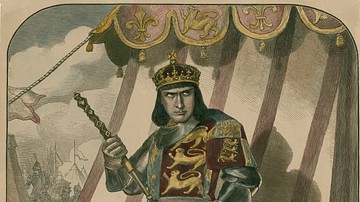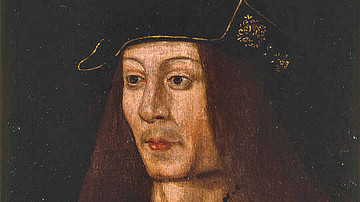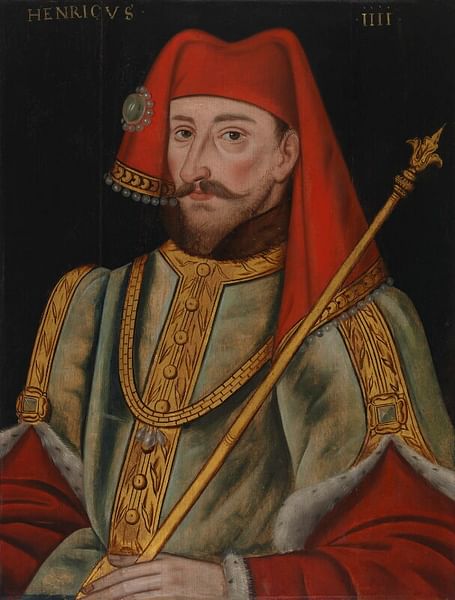
Henry IV of England ruled as king from 1399 to 1413 CE. Known as Henry Bolingbroke, Duke of Lancaster before he became king, Henry clashed with his cousin Richard II of England (r. 1377-1399 CE) and was exiled in 1397 CE. Returning to England with a small army in the summer of 1399 CE, Henry made himself king as Richard's support collapsed. Kicking off his reign with the murder of his predecessor, Henry would face major rebellions in both England and Wales, and he frequently clashed with Parliament, particularly the 'Long Parliament' of 1406 CE. Henry was the first of the kings from the House of Lancaster and he was succeeded by his son Henry V of England (r. 1413-1422 CE).
Birth & Family
Henry was born in April 1366 CE at Bolingbroke Castle in Lincolnshire, the son of John of Gaunt (l. 1340-1399 CE), himself the son of Edward III of England (r. 1327-1377 CE) and so a claimant for the throne of Richard II (who was the grandson of Edward III and the son of Edward the Black Prince, l. 1330-1376 CE). John was a powerful but unpopular figure who had been passed over for the throne because he had supported corrupt nobles and officials identified by Parliament. Henry Bolingbroke's mother was Blanche of Lancaster, daughter of the Duke of Lancaster. The young nobleman was given the title Earl of Derby, the first of many he would acquire over his career.
Henry married Mary of Bohun (b. c. 1369 CE) on 5 February 1381 CE, but she died during childbirth in 1394 CE. The couple's most famous son was Henry, future Henry V, born on 16 September 1387 CE. Henry, now king, married again on 7 February 1403 CE, this time to Joan of Navarre (l. c. 1370-1437 CE). Henry had a typical noble upbringing where he showed a flair for the medieval tournament, courage, piety, and an interest in literature. The young Henry had his share of adventure when he twice went to fight pagans in Lithuania as part of the long-running Northern Crusades (12-15th century CE) alongside Teutonic Knights. There would also be a pilgrimage to Jerusalem before he concentrated on his ambitions in England.
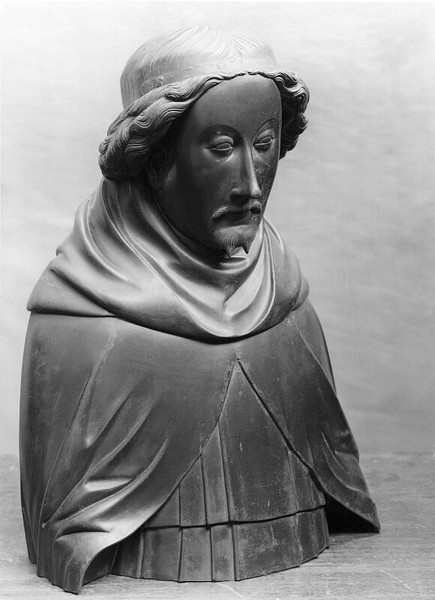
Rivalry with Richard II
By 1386 CE Henry Bolingbroke had risen to be one of the foremost barons in England, and he was a member of the disgruntled group of noblemen who took exception to the king's favouritism towards Robert de Vere, Earl of Oxford. Richard had made the hugely unpopular de Vere the Duke of Ireland in December 1387 CE. The dissatisfied barons made their move by defeating de Vere and his supporters at the Battle of Radcot Bridge near Oxford. Henry was then one of the five Lords Appellant who called the 'Merciless Parliament' to take power away from the still young Richard II. The king would get his revenge, though, in 1397 CE when, older, wiser and more secure on his throne, he rounded up the conspirators and had them executed or exiled. Henry, the king's cousin, was, fortunately for him, in the latter category.
Initially, it seemed Henry had survived the king's purge, but a quarrel between Bolingbroke and Thomas Mowbray, Duke of Norfolk - the two surviving Lords Appellant, which was engineered by Richard, resulted in the two dukes facing each other in a medieval joust in Coventry in September 1398 CE. With a huge crowd waiting expectantly to witness the finale of an event rich in pageantry, the king stepped forward and forbade the two to fight. Richard then exiled Mowbray for life and Bolingbroke for ten years. Henry went off to Paris but he would be back in England far sooner than Richard had hoped.
On 3 February 1399 CE John of Gaunt died and so Henry became the Duke of Lancaster. Henry now had an excuse to return to England - he could claim he wanted back what was rightfully his, the Lancaster family's lands which Richard had taken for himself. The king had also extended Henry's exile from 10 years to life. As it turned out, though, Henry would be back not only to claim his estates but also a much bigger prize.
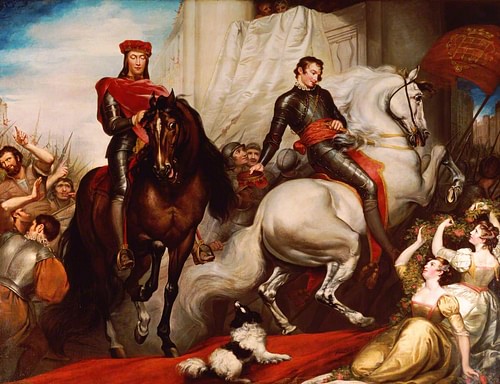
Seizure of the Throne
Henry set off from Boulogne and landed at Spurn Head northeast England with a small army, perhaps only 300 men, and then marched south to press his claim in June-July 1399 CE. The timing of the invasion was excellent because Richard was then away in Ireland. Without their king, the royalist support faded away, perhaps, too, because Richard had never been all that popular with his odd choice of court companions and distinct lack of verve in taking the war to the French during the Hundred Years' War (1337-1453 CE).
The war with the French had started fantastically well for England but by Richard's reign, Charles V of France, aka Charles the Wise (r. 1364-1380 CE), had ensured that the only lands left in France belonging to the English Crown were Calais and a thin slice of Gascony. French pirates were running riot in the English Channel and many English barons wanted a more direct war than the fizzled-out one they were currently witnessing. Richard failed in two of the most important areas a medieval king was expected to do well: win military victories to bring in money and lands, and produce a male heir. When these failures were added to his dictatorial approach to government, it becomes clearer why the barons entertained the idea of a change in ruler, especially as Henry was a capable military leader, had a forceful personality and was of royal blood himself.
In August 1399 CE Richard was back from Ireland and enticed out of hiding in Conwy Castle in Wales, only to be then imprisoned in the Tower of London. On 29 September Henry obliged Richard to sign his own abdication. On 30 September, Parliament officially nominated Henry as Richard's successor, and so Henry Bolingbroke was crowned Henry IV of England on 13 October 1399 CE in a lavish ceremony at Westminster Abbey. In a curious incident, the king dropped the gold coin that newly-crowned monarchs were supposed to ceremoniously offer to God. The coin rolled away and was never seen again, an ill omen indeed. To signal the beginning of a new era, on the eve of his coronation Henry had created a new group of medieval knights called the Knights of Bath (what would become much later the chivalric Order of Bath). Henry, who himself took a bath every week - an unusual frequency for the Middle Ages - created 46 such knights and they all had to have a bath as a mark of purification and be blessed by a priest before they were invested.
On 14 February 1400 CE the ex-king was murdered in Pontefract Castle in Yorkshire, almost certainly because there had been some, albeit minor, efforts by those loyal to Richard to set him back on the throne. Henry even put the body of Richard on public display in the Tower of London in case any would-be rebels thought he might still be alive and ready to head a coup. The Plantagenets who had ruled England since Henry II of England (r. 1154-1189 CE) were now replaced by the House of Lancaster.
Rebellion
Henry faced an immediate crisis in September 1400 CE in Wales where Owain Glyn Dwr (b. c. 1359 CE) had declared himself the Prince of Wales. Even more ominously, the Welshman had the support of The Earl of March, whose son Edmund Mortimer, as the great-great-grandson of Edward III, was a possible claimant to Henry's throne. Also supporting the Welsh were the French taking, as usual, any opportunity to destabilise the English throne. Meanwhile, English barons were plotting a rebellion of their own in England. The group of discontents included such notable names as the Earl of Worcester, the Earl of Northumberland, and the celebrated medieval knight Sir Henry 'Hotspur' Percy (1364-1403 CE).
Henry first turned to the English problem and met in battle the rebellious barons on 21 July 1403 CE at the Battle of Shrewsbury. The king's army was victorious, Henry fought with courage, Sir Percy was killed and Worcester executed. The Earl of Northumberland, Earl of March, and other rebel barons would not give up so easily and they changed strategy and began to conspire with the Archbishop Scrope of York and Owain Glyn Dwr. King Henry discovered this plot to carve up his kingdom from under his feet, and the Earl of Northumberland fled to Scotland.
Things improved for Henry as the decade wore on. In March 1406 CE the young Prince James, the future James I of Scotland (1406-1437 CE), was captured when his ship was wrecked off the east coast of England. Prince James was kept as a prisoner in the Tower of London and a hefty ransom demanded for his release. Unfortunately for James, his father died soon after, and although he became the king of Scotland, nobody came forward with the ransom and so he was kept in comfortable confinement for 18 years.
In February 1408 CE, after Henry won the Battle of Bramham Moor against the combined Welsh and English rebels, Edmund Mortimer was imprisoned and both the Archbishop of York and the Earl of Northumberland were executed. In 1409 CE, the Welsh rebellion was finally quashed when the last rebels were captured at Harlech Castle. Owain Glyn Dwr retreated to the mountains and was never heard of again.
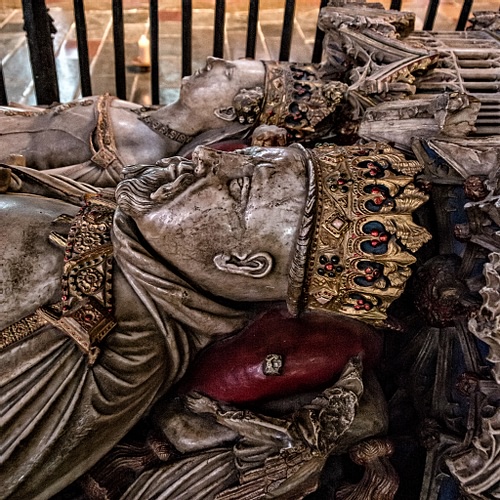
Henry's namesake son had led the army that regained Harlech, capturing the eldest son of Owain Glyn Dwr in the process, and he was fast becoming the star of the royal court. Prince Henry, who was the 'real' Prince of Wales, also led an army to France to exploit the anarchy there following the descent into madness of King Charles VI of France (r. 1380-1422 CE), but the expedition came to nothing. Still, the prince was outshining his father and there developed some friction between the two, especially over the Prince's desire to take a more militaristic approach with their great rival France. The younger Henry's time would come soon enough.
The Long Parliament
Another source of friction at court was the king's relationship with Parliament. The so-called 'Long Parliament' of 1406 CE sat an unusually long time from March until December as it deliberated over the ever-prickly issue of state finances. Parliament was not impressed with the lack of success against the Welsh rebels or the presence of French troops in Wales. The king's high taxes were not yielding any results on the field of battle, the court spending was considered excessive, and Parliament insisted that, at the very least, the king must listen to its concerns before endorsing a new round of taxes. Thus, the 'Long Parliament' was another small step on the long road to a constitutional monarchy.
Death & Successor
Henry IV died on 20 March 1413 CE. He was only around 46 and had been wasting away, wracked by disease - possibly leprosy or severe eczema - since 1406 CE. In addition, the king suffered multiple strokes at the end of his life and this when his mind had already long been troubled with remorse for his treatment of King Richard. He was buried in Canterbury Cathedral. Henry was succeeded by his 25-year-old son, Henry V of England who was crowned in Westminster Abbey on 9 April 1413 CE. Henry V became one of the great fighting monarchs of European history by defeating the French at the Battle of Agincourt in 1415 CE and going on to capture Normandy and Paris. However, his reign would be brief, cut short by illness, and the ousting of the legitimate King Richard would come to haunt the Lancaster descendants as the two houses of Lancaster and York battled for the throne in what became known as the Wars of the Roses (1455-1487 CE).

